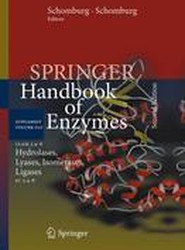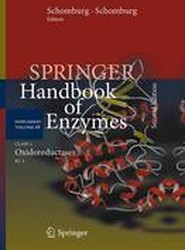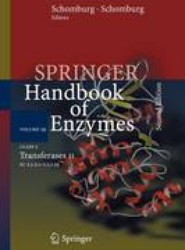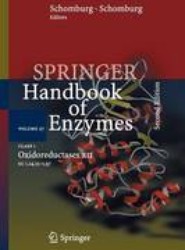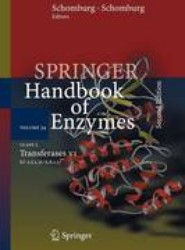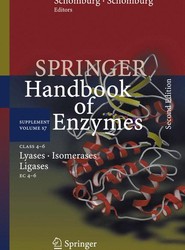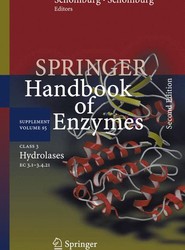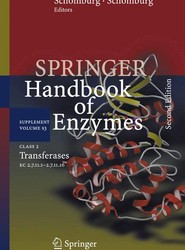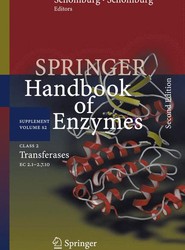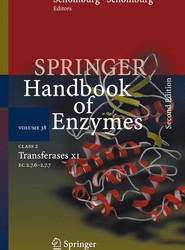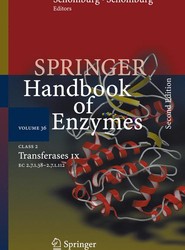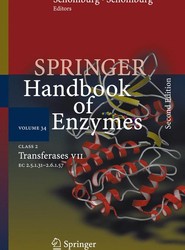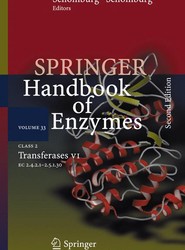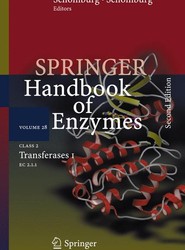(To see other currencies, click on price)
MORE ABOUT THIS BOOK
Main description:
Springer Handbook of Enzymes provides data on enzymes sufficiently well characterized. It offers concise and complete descriptions of some 5,000 enzymes and their application areas. Data sheets are arranged in their EC-Number sequence and the volumes themselves are arranged according to enzyme classes.
This new, second edition reflects considerable progress in enzymology: many enzymes are newly classified or reclassified. Each entry is correlated with references and one or more source organisms. New datafields are created: application and engineering (for the properties of enzymes where the sequence has been changed). The total amount of material contained in the Handbook has more than doubled so that the complete second edition consists of 39 volumes as well as a Synonym Index. In addition, starting in 2009, all newly classified enzymes are treated in Supplement Volumes.
Springer Handbook of Enzymes is an ideal source of information for researchers in biochemistry, biotechnology, organic and analytical chemistry, and food sciences, as well as for medicinal applications.
Feature:
Offers concise and complete description of about 5,000 enzymes sufficiently well characterized as well as their application in analytical, synthetic and biotechnology processes, in food industry, and for medicinal treatments.
This new, second edition reflects considerable progress in enzymology: many of the enzymes have either been newly classified, or re-classified
Content in this new edition has doubled: now consists of 39 volumes as well as a synonym index
Starting in 2009 all newly classified enzymes are treated in the Supplement Volumes
Available in print as well as online
Back cover:
Springer Handbook of Enzymes provides data on enzymes sufficiently well characterized. It offers concise and complete descriptions of some 5,000 enzymes and their application areas. Data sheets are arranged in their EC-Number sequence and the volumes themselves are arranged according to enzyme classes.
This new, second edition reflects considerable progress in enzymology: many enzymes are newly classified or reclassified. Each entry is correlated with references and one or more source organisms. New datafields are created: application and engineering (for the properties of enzymes where the sequence has been changed). The total amount of material contained in the Handbook has more than doubled so that the complete second edition consists of 39 volumes as well as a Synonym Index. In addition, starting in 2009, all newly classified enzymes are treated in Supplement Volumes.
Springer Handbook of Enzymes is an ideal source of information for researchers in biochemistry, biotechnology, organic and analytical chemistry, and food sciences, as well as for medicinal applications.
Contents:
(+)-trans-Carveol dehydrogenase.- Serine 3-dehydrogenase.- 3?-Hydroxy-5?-steroid dehydrogenase.- 3?-Hydroxy-5?-steroid dehydrogenase.- (R)-3-Hydroxyacid-ester dehydrogenase.- (S)-3-Hydroxyacid-ester dehydrogenase.- GDP-4-dehydro-6-deoxy-d-mannose reductase.- Quinate/shikimate dehydrogenase.- Methylglyoxal reductase (NADPH-dependent).- S-(Hydroxymethyl)glutathione dehydrogenase.- 3?-Deamino-3?-oxonicotianamine reductase.- Isocitrate-homoisocitrate dehydrogenase.- d-Arabinitol dehydrogenase (NADP+).- Xanthoxin dehydrogenase.- Sorbose reductase.- 4-Phosphoerythronate dehydogenase.- 2-Hydroxymethylglutarate dehydrogenase.- 1,5-Anhydro-d-fructose reductase (1,5-anhydro-d-mannitol-forming).- Chlorophyll(ide) b reductase.- Quinoprotein glucose dehydrogenase.- Pyranose dehydrogenase (acceptor).- 2-Oxo-acid reductase.- (S)-Mandelate dehydrogenase.- l-Sorbose 1-dehydrogenase.- Glutamyl-tRNA reductase.- Succinylglutamate-semialdehyde dehydrogenase.- Erythrose-4-phosphate dehydrogenase.- Abscisic-aldehyde oxidase.- Carbon-monoxide dehydrogenase (ferredoxin).- Aldehyde ferredoxin oxidoreductase.- Glyceraldehyde-3-phosphate dehydrogenase (ferredoxin).- 3-Methyl-2-oxobutanoate dehydrogenase (ferredoxin).- Indolepyruvate ferredoxin oxidoreductase.- 2-Oxoglutarate ferredoxin oxidoreductase.- Aldehyde dehydrogenase (FAD-independent).- Precorrin-2 dehydrogenase.- Anthocyanidin reductase.- Arogenate dehydrogenase (NADP+).- Arogenate dehydrogenase [NAD(P)+].- Red chlorophyll catabolite reductase.- Tryptophan ?,?-oxidase.- Pyrroloquinoline-quinone synthase.- l-Galactonolactone oxidase.- Coproporphyrinogen dehydrogenase.- all-trans-Retinol 13,14-reductase.- Aspartate dehydrogenase.- l-Lysine 6-oxidase.- 1-Pyrroline dehydrogenase.- Methylenetetrahydrofolate reductase (ferredoxin).- PreQ1 synthase.- Hydroxylamine oxidoreductase.- Peptide-methionine (S)-S-oxide reductase.- Peptide-methionine (R)-S-oxide reductase.- l-Methionine (S)-S-oxide reductase.- l-Methionine (R)-S-oxide reductase.- Thiosulfate dehydrogenase (quinone).- CoB-CoM Heterodisulfide reductase.- Sulfiredoxin.- Ribosyldihydronicotinamide dehydrogenase (quinone).- Violaxanthin de-epoxidase.- Peroxiredoxin.- Versatile peroxidase.- 9-cis-Epoxycarotenoid dioxygenase.- Indoleamine 2,3-dioxygenase.- Acireductone dioxygenase (Ni2+-requiring).- Acireductone dioxygenase [iron(II)-requiring].- Sulfur oxygenase/reductase.- Oplophorus-luciferin 2-monooxygenase.- Chlorophyllide-a oxygenase.- Flavone synthase.- Flavonol synthase.- 2?-Deoxymugineic-acid 2?-dioxygenase.- Mugineic-acid 3-dioxygenase.- Deacetoxycephalosporin-C hydroxylase.- [histone-H3]-Lysine-36 demethylase.- Proline 3-hydroxylase.- 3-Phenylpropanoate dioxygenase.- Pheophorbide a oxygenase.- Vanillate monooxygenase.- Precorrin-3B synthase.- 4-Hydroxyacetophenone monooxygenase.- Glyceollin synthase.- 2-Hydroxyisoflavanone synthase.- Licodione synthase.- Flavonoid 3?,5?-hydroxylase.- Isoflavone 2?-hydroxylase.- Zeaxanthin epoxidase.- Deoxysarpagine hydroxylase.- Phenylacetone monooxygenase.- (+)-Abscisic acid 8?-hydroxylase.- Lithocholate 6?-hydroxylase.- 7?-Hydroxycholest-4-en-3-one 12?-hydroxylase.- 5?-Cholestane-3?,7?-diol 12?-hydroxylase.- Taurochenodeoxycholate 6?-hydroxylase.- Cholesterol 24-hydroxylase.- 24-Hydroxycholesterol 7?-hydroxylase.- 25-Hydroxycholesterol 7?-hydroxylase.- Senecionine N-oxygenase.- Psoralen synthase.- 8-Dimethylallylnaringenin 2?-hydroxylase.- CMP-N-Acetylneuraminate monooxygenase.- Lathosterol oxidase.- Cholesterol 25-hydroxylase.- Cob(II)yrinic acid a,c-diamide reductase.- Xanthine dehydrogenase.- Nicotinate dehydrogenase.- Bile-acid 7?-dehydroxylase.- Xanthine oxidase.- 6-Hydroxynicotinate dehydrogenase.- Phenylacetyl-CoA dehydrogenase.- 3?, 7?, 12?-Trihydroxy-5?-cholestanoyl-CoA 24-hydroxylase.- Uracil/thymine dehydrogenase.- Bile-acid 7 ?-dehydroxylase.- Aureusidin synthase.- Selenate reductase.- Thyroxine 5?-deiodinase.- Thyroxine 5-deiodinase.
PRODUCT DETAILS
Publisher: Springer (Springer Berlin Heidelberg)
Publication date: January, 2009
Pages: 822
Weight: 1424g
Availability: Not available (reason unspecified)
Subcategories: Biochemistry, General Issues, Pharmacology, Veterinary Medicine
From the same series
CUSTOMER REVIEWS
ChemBioChem 3/2002: Comparing Volume 2 of the first edition with Volume 1 of the second edition one rapidly notices that an incredible amount of work was spent on updating the different datafields.
The handbook is definitely worth buying, since it is probably the best reference manual available to date and is, therefore, an improtant acquisition for libraries. (W. Kroutil, University of Graz)



